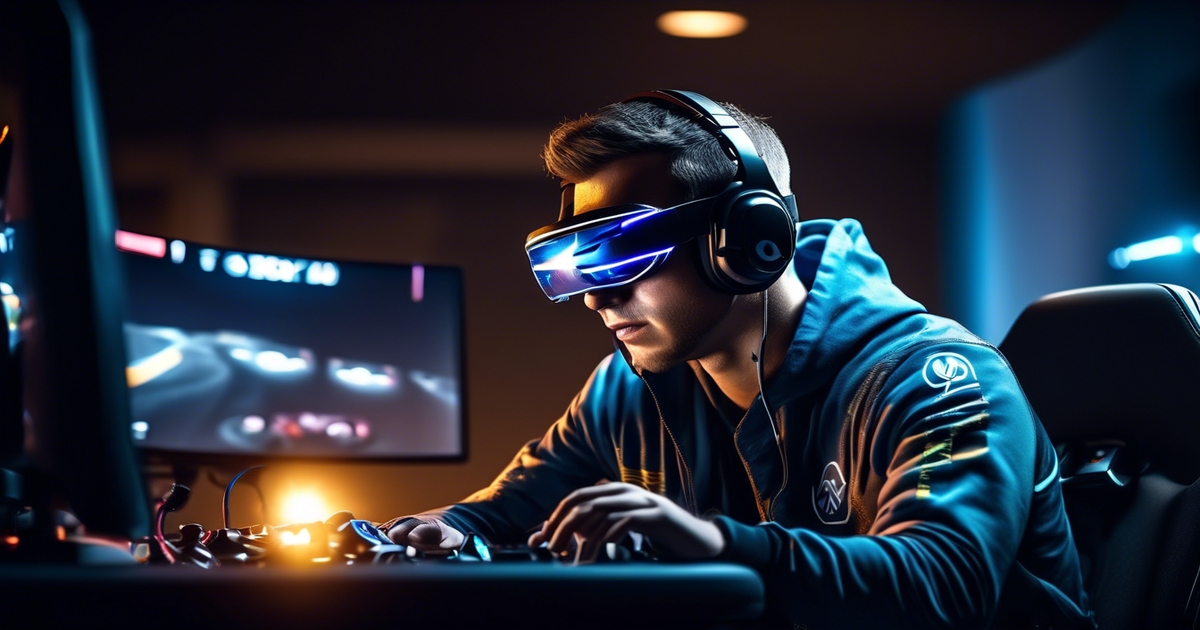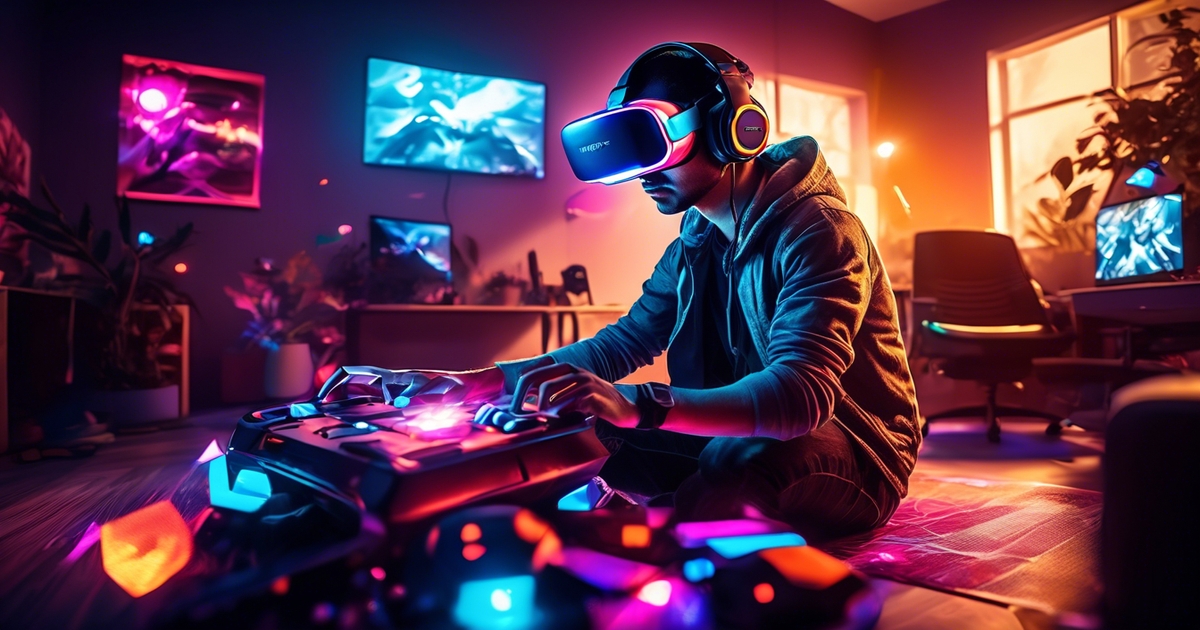Future of Gaming: Trends, Technologies & Predictions

- Key Takeaways
- Trends shaping the future of gaming
- Technologies revolutionizing gameplay
- The convergence of VR and AR in gaming
- The rise of cloud gaming and accessibility
- The impact of AI on game development and player experiences
- Blockchain and NFTs transforming gaming economies
- The evolution of esports and competitive gaming
- The role of Web3 tech in decentralizing gaming
- Predictions for the next decade in video game evolution
- Final Remarks
- Frequently Asked Questions
The future of gaming is an ever-evolving landscape, driven by technological advancements and changing consumer preferences. From virtual reality experiences to cloud gaming services, the possibilities seem limitless. As developers push boundaries with immersive storytelling and realistic graphics, gamers are experiencing a new era of entertainment. The rise of mobile gaming and esports has transformed how we play and compete, creating opportunities for players worldwide to connect and engage in ways previously unimaginable.
Discover how emerging technologies like artificial intelligence and augmented reality are revolutionizing gameplay experiences. Stay tuned as we unravel the exciting developments that promise to redefine the way we game in the coming years.
Key Takeaways
- Stay ahead by embracing trends in gaming development and technology.
- Explore the immersive possibilities of VR, AR, and how they enhance gameplay experiences.
- Embrace cloud gaming for on-the-go and accessible gaming experiences.
- AI is reshaping games; leverage its potential for enhanced player interactions.
- Understand the impact of blockchain and NFTs on in-game economies for new opportunities.
- Keep an eye on esports growth and the role of Web3 in decentralizing gaming platforms.
Trends shaping the future of gaming

The future of gaming is being significantly influenced by several key trends. One prominent trend is the increasing popularity of mobile gaming worldwide. Mobile games are becoming more sophisticated, attracting a broader audience beyond traditional gamers. This trend has led to an explosion in the number and variety of mobile games available, catering to different preferences and demographics.
Another crucial trend shaping the future of gaming is the growing demand for cross-platform gaming experiences. Players now expect seamless transitions between different devices without losing progress or features. For example, a gamer might start playing a game on their console at home and then continue where they left off on their smartphone during their commute. This trend challenges developers to create cohesive experiences across multiple platforms, ensuring that players can enjoy their favorite games wherever they are.
Moreover, the rise of cloud-based gaming services is revolutionizing how games are played and accessed. Cloud gaming allows players to stream high-quality games directly to their devices without needing expensive hardware or downloads. Services like Google Stadia and Microsoft xCloud exemplify this shift towards cloud-based gaming, offering gamers instant access to a vast library of titles without requiring powerful consoles or PCs.
Technologies revolutionizing gameplay

Advancements in gaming technology have paved the way for the future of gaming. Developers are constantly pushing boundaries with realistic graphics and rendering technologies, providing players with visually stunning gaming experiences. For instance, games like “The Last of Us Part II” showcase lifelike environments and character details that immerse players in a whole new level of gameplay.
The integration of virtual reality (VR) and augmented reality (AR) is transforming the way video games are played. VR headsets transport players into interactive worlds where they can explore, interact, and engage with their surroundings as if they were truly there. On the other hand, AR enhances real-world environments by overlaying digital elements onto them. Games like “Pokemon Go” have successfully merged AR technology with traditional gaming concepts to create unique and engaging experiences for players.
Another groundbreaking innovation shaping the future of gaming is the emergence of haptic feedback systems. These systems provide tactile feedback to players through vibrations or sensations, enhancing immersion and making gameplay more interactive than ever before. With haptic feedback, players can feel every action within a game – from firing a weapon to driving a car – adding a new dimension to their gaming experience.
The convergence of VR and AR in gaming

Virtual reality (VR) has transformed the gaming landscape, offering players immersive experiences by transporting them to virtual lands where they can interact with the environment. This technology allows gamers to step into a completely different world, engaging all their senses in gameplay.
On the other hand, augmented reality (AR) enriches real-world gaming experiences by overlaying digital elements onto the physical environment. For example, games like Pokémon GO utilize AR to blend virtual creatures into real-world settings, creating an interactive and dynamic experience for players. This approach merges the virtual and physical worlds seamlessly.
The potential for multiplayer AR gaming experiences opens up new possibilities for collaborative gameplay among friends or within a community setting. Imagine being able to team up with others physically present around you while simultaneously interacting with digitally enhanced elements in your surroundings. This integration of technology fosters social interaction and shared gaming moments.
The rise of cloud gaming and accessibility
Cloud gaming services have revolutionized the future of gaming by enabling players to stream games on various devices, regardless of their hardware specifications. This advancement in technology has significantly increased access to games for individuals with lower-spec devices or limited storage space. By utilizing cloud-based platforms, players can enjoy high-quality gaming experiences without the need for expensive equipment.
The popularity of cloud gaming platforms continues to rise due to their ability to eliminate the reliance on physical game copies. Players no longer need to purchase discs or download large game files, as they can simply access their favorite titles through a network connection. This not only simplifies the gaming process but also allows users to share and play games seamlessly across different devices using cloud-based services.
The impact of AI on game development and player experiences
Artificial intelligence (AI) is revolutionizing the future of gaming, enhancing both game development and player interactions. With AI-powered non-playable characters (NPCs), players can enjoy more lifelike and dynamic engagements within games, creating a richer gaming experience. These NPCs are designed to respond intelligently to player actions, making each interaction unique and unpredictable.
AI algorithms play a crucial role in shaping the experiences players have in games by optimizing environments based on individual preferences and behaviors. This means that as a player progresses through a game, the environment adapts to their choices, creating a personalized gaming journey. By leveraging AI for procedural content generation, developers can create vast worlds that feel tailored to each player’s style of play.
On the development side, AI assists in various tasks such as game testing and bug detection. By automating these processes, developers can identify issues quicker, leading to faster turnaround times for fixes and updates. This results in more polished games being released to players sooner, ultimately improving overall experience for gamers worldwide.
Pros:
- Enhanced realism with AI-powered NPCs.
- Personalized gaming environments based on player behavior.
- Faster development cycles with AI-assisted testing.
Cons:
- Potential challenges integrating complex AI systems into game development pipelines.
Blockchain and NFTs transforming gaming economies
Blockchain technology is revolutionizing the future of gaming by ensuring secure ownership and trading of in-game assets. By integrating blockchain, players can have verified ownership of their virtual items, preventing fraud or duplication. This technology also enables transparent and secure transactions through the use of cryptocurrency.
Non-fungible tokens (NFTs) are playing a significant role in reshaping gaming economies by allowing unique digital item ownership. Players can purchase exclusive in-game assets as NFTs, giving them rare collectibles with inherent value. These tokens offer monetization opportunities for gamers who can sell their valuable NFTs to other players or collectors, creating a new marketplace within games.
Decentralized marketplaces powered by blockchain empower players to directly engage in buying, selling, and trading virtual assets without the need for intermediaries. Through decentralized platforms, gamers have more control over their in-game purchases and sales. They can participate in peer-to-peer transactions securely using smart contracts that automatically execute agreements between buyers and sellers.
In this evolving landscape where NFTs and blockchain technologies intersect with gaming economies, there are several key advantages driving this transformation:
- Increased security: Blockchain ensures tamper-proof records of asset ownership.
- Unique ownership: NFTs provide one-of-a-kind digital items that hold real-world value.
- Direct transactions: Decentralized marketplaces enable direct player interactions without third-party involvement.
On the flip side, challenges such as scalability issues with blockchain networks may hinder widespread adoption among mainstream game developers:
- Scalability concerns: Blockchain networks face limitations on processing high volumes of transactions quickly.
- Energy consumption: The environmental impact of cryptocurrency mining raises sustainability questions.
The evolution of esports and competitive gaming
Esports is rapidly evolving into a mainstream form of entertainment, with large-scale tournaments and professional leagues gaining immense popularity. This evolution has seen a surge in investments towards esports infrastructure, including dedicated arenas and broadcasting platforms to cater to the growing audience demand for competitive gaming content.
The industry is witnessing an expansion of esports into new game genres, leading to increased diversity in competitive gaming. As more companies enter the market, there is a rising interest in tapping into different talent pools within the esports community. This influx of diverse talent not only enriches the competitive landscape but also brings new challenges and opportunities for players looking to make their mark in the future of gaming.
Pros:
- Increased exposure and recognition for esports athletes.
- Diversification of game genres attracting a wider audience.
- Opportunities for talented individuals from various backgrounds to excel in competitive gaming.
Cons:
- Intense competition can lead to high levels of stress among players.
- Challenges associated with maintaining inclusivity and diversity within the industry.
Investments made by companies are transforming how people perceive video games, shifting them from mere sources of fun to serious competitions that require dedication and skill. With years ahead on this journey, it’s clear that esports has come a long way since its inception as a niche activity enjoyed by enthusiasts.
The role of Web3 tech in decentralizing gaming
Web3 technologies are revolutionizing the future of gaming by enabling decentralized game development and distribution. Through blockchain technology, games can be created and shared without central authorities, giving more power to developers and players alike. This decentralization allows for greater creativity, innovation, and diversity in the gaming industry.
Integrating blockchain and smart contracts into games ensures transparent and fair gameplay mechanics. By leveraging these technologies, issues like cheating or unfair advantages can be minimized or eliminated entirely. For example, blockchain can track in-game assets securely, preventing duplication or fraud. Smart contracts enable automated execution of game rules without human intervention, ensuring a level playing field for all participants.
Player-driven economies and governance models are emerging through decentralized autonomous organizations (DAOs) in the gaming world. These DAOs empower players to have a say in the development of games, virtual economies, and community decisions. Players can vote on changes or proposals within a game ecosystem, influencing its direction collectively. This shift towards player-driven governance fosters community engagement and loyalty while promoting inclusivity among gamers.
Predictions for the next decade in video game evolution
The future of gaming holds exciting developments, with mobile gaming set to continue its growth trajectory. Mobile games will become more advanced, offering players increasingly sophisticated experiences thanks to improved hardware capabilities. For instance, smartphones are expected to have better graphics and processing power, enabling more visually stunning and complex games.
Moreover, advancements in virtual reality technology will play a significant role in shaping the next generation of gaming. These innovations will lead to more immersive and realistic gameplay experiences for gamers worldwide. Imagine being able to step into a virtual world that feels incredibly lifelike and engaging, blurring the lines between reality and gaming even further.
The integration of AI, blockchain technology, and Web3 into the gaming industry is poised to bring about a revolution in game development practices. Developers will leverage AI algorithms for smarter NPCs (non-playable characters) and dynamic storytelling elements. Blockchain technology will enable secure in-game asset ownership through NFTs (non-fungible tokens), while Web3 platforms will offer new ways for players to interact within game ecosystems.
Pros:
- More sophisticated mobile gaming experiences
- Enhanced realism through virtual reality advancements
- Revolutionized game development with AI, blockchain, and Web3 tech
Cons:
- Potential challenges with data privacy in AI-driven games
- Barriers to entry for smaller developers adopting blockchain technologies
Final Remarks
The future of gaming is poised for a remarkable transformation driven by cutting-edge technologies like VR, AR, cloud gaming, AI, blockchain, and NFTs. These innovations are reshaping gameplay experiences, redefining competitive landscapes, and revolutionizing how players interact with virtual worlds. As the industry hurtles towards a new era marked by decentralization and immersive technologies, gamers and developers alike must adapt to stay ahead of the curve.
In this ever-evolving landscape, embracing change and staying abreast of emerging trends will be crucial for anyone invested in the gaming sphere. Whether you’re a player seeking new adventures or a developer crafting the next big hit, understanding and leveraging these advancements will be paramount. The future of gaming holds endless possibilities for those willing to explore and innovate. Stay informed, stay engaged, and get ready to level up in this thrilling journey into the next decade of video game evolution.
Frequently Asked Questions
What are the key technologies driving the future of gaming?
The key technologies driving the future of gaming include VR, AR, cloud computing, AI, blockchain, NFTs, and Web3 tech. These innovations are revolutionizing gameplay experiences and shaping the landscape of the gaming industry.
How is AI impacting game development and player experiences?
AI is transforming game development by enhancing procedural generation, creating dynamic environments, personalizing player experiences through adaptive algorithms. It also powers NPCs with realistic behaviors and improves matchmaking systems for better player engagement.
Can you explain how blockchain and NFTs are transforming gaming economies?
Blockchain technology enables secure in-game asset ownership and trading while NFTs authenticate digital items’ scarcity and uniqueness. This innovation empowers players to truly own their virtual assets across different games and platforms, fostering a new era of digital ownership.
What role does Web3 technology play in decentralizing gaming?
Web3 technology enhances decentralization in gaming by enabling peer-to-peer interactions without intermediaries. Smart contracts on blockchain networks facilitate transparent transactions within games while empowering players with greater control over their data privacy and virtual assets.
What trends can we expect to see in esports over the next decade?
In the next decade, esports will continue to grow exponentially with increased viewership, larger prize pools for tournaments. Expect more professional leagues forming around popular titles like League of Legends or Overwatch as traditional sports organizations further invest in competitive gaming.
